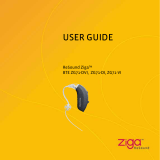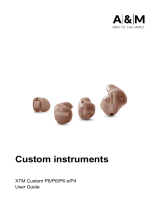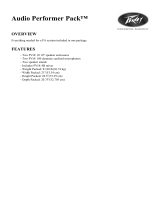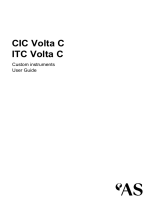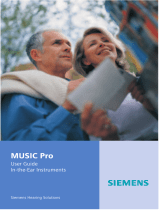Page is loading ...

USER GUIDE
ReSound Clip Bodyworn
CP1BW-V, CP1PBW-V, CP2BW-V,
CP2BW-PV, CP3BW-PVI

2 3
This booklet & your instrument
In this booklet you will find instructions for inserting,
using and caring for your new hearing instrument.
Contents page
Your ReSound Clip Hearing Instruments 4
On/Off Function 7
Low Battery Warning 7
Changing the Battery 8
Battery Warning Information 8
Assembling of Cord & Earphone 9
Inserting & Removing your hearing instrument 10
Using two ear phones 12
Wearing the instrument 12
Pre-Set controls – trimmers 13
User operated controls 13
Volume Control 13
Programme Selector 14
Direct Audio-input facility 17
Telephone use 18
Using loop systems 19
Daily Maintenance 20
Repairs 20
Ear Mould 21
Cleaning the Ear Mould 21
General Precautions 22
Technical Data 23
Troubleshooting Guide 24
Key Word Index 26
RESOUND CLIP BODYWORN
PERSONAL HEARING SYSTEM
Congratulations on the purchase of your new ReSound
hearing instrument!
This booklet describes the features available for the
Bodyworn hearing instrument models in the ReSound
Clip product line. The available options depend on the
hearing instrument model; your hearing care profes-
sional will highlight the features of your particular hear-
ing instrument.
ReSound’s advanced technology and customized
programmes, selected by your hearing care profes-
sional, will offer you the best possible hearing solution
to maximize listening situations in your family life, your
professional life and your social life.
Your hearing instrument has been adjusted for your
individual hearing loss. Please familiarize yourself with
the information in this booklet. Proper understanding
and use of your new ReSound hearing instrument will
allow you to derive maximum hearing benefit.
This instruction manual covers the following ReSound
Clip Bodyworn products:
CP1BW-V, CP1PBW-V, CP2BW-V, CP2BW-PV,
CP3BW-PVI
ReSound Clip is a trademark of ReSound A/S

4 5
M
T
Your ReSound Clip CP1BW-V
hearing instrument
Your ReSound CP1PBW-V, CP2BW-V,
CP2BW-PV hearing instruments
1. Microphone
2. Volume Control
3. Programme selector
or M-T switch
4. Battery Compartment
5. On/off
1. Microphone
2. Volume Control
3. Programme selector
4. Battery Compartment
6. Trimmers
7. Earphone cable
8. Clip
9. Model, manufacturer
and serial number
5. On/off
6. Earphone cable
7. Clip
8. Model, manufacturer
and serial number
1 1
7 8
6
7
2 2
5 5
3 3
4 4
6
8
9

6 7
Turning on and off
Your ReSound Clip Bodyworn
is equipped with an on/off
switch.
Turn your hearing instrument
on by pushing the On/Off switch
down, and turn your instrument
off again by pushing the On/Off
switch up.
When first turned on, your Clip1+, Clip2 and Clip3 hearing
instruments will always start in programme 1. To read more
on this subject, turn to page 14-16.
It is recommended that you turn your hearing instrument off
and open the battery door when you are not using it. This
will increase the battery life as well as increase the life span
of the hearing instrument.
Low Battery Warning
The hearing instrument has a soft low-battery-warning sig-
nal (beep-beep) that you will hear when the battery voltage/
power gets too low. The low-battery-warning signal will be
repeated every 5-10 minutes until the battery runs out of
power. The instrument will then automatically switch off.
For CP1PBW-V, the low-battery warning signal will produce
continuous beeps when the battery voltage runs low, until
the battery runs completely out of power and automatically
switches off.
It is recommended that you always carry a spare battery
with you and replace the battery as soon as you hear the
low battery warning signal.
On the top left of CLIP 3 (CP3BW-PVI) Hearing instrument
there is also a battery light indicator whitch will warn you
when the battery voltage/power gets too low.
Your ReSound Clip CP3BW-PVI
hearing instrument
1. Microphone
2. Volume Control
3. Programme selector
4. Battery Compartment
5. On/off
6. Trimmers
7. Earphone cable
8. Clip
9. Battery indicator
10. Model, manufacturer
and serial number
1
8
7
2
5
3
4
6
9
10

8 9
Changing the Battery
The battery compartment can be
opened on the side just below the
On/Off switch.
Insert the new battery with the +
side facing the + inside the battery
compartment. If you are replacing
an old battery please remove this
with the help of the transparent
Battery Remove Band before
inserting a new one.
Always use a type 1.5 volt Penlight (IEC 86-R03/AAA) battery,
and it is recommended to use Alkaline battery for longer
battery life time. Please note that a weak battery can cause
the hearing instrument power to be reduced.
Please read battery warning information carefully.
Battery Warning information
Batteries contain dangerous substances and should be dis-
posed of carefully in the interest of your safety and for the
environment.
If the batteries are not inserted correctly, the device
will not work and the batteries may build up heat. If this
happens, please remove the batteries (Please be aware
that the batteries might be hot so make sure to use the
removal strip). Insert new batteries in correct orienta-
tion.
• Do NOT attempt to recharge batteries which are not
specifically designated rechargeable as they may leak or
explode.
• Do NOT attempt to dispose of batteries by burning
them.
• Keep batteries away from small children and pets.
• Do NOT place batteries in your mouth.
If swallowed, seek immediate medical attention.
Assembling of Cord & Earphone
The hearing instrument will only function when an ear phone
receiver is connected to the main body through an ear
phone cable and the USB-like plug marked in the illustra-
tion below.
Insert the cable in the receiver outlet indicated and insert the
cable in the ear phone, please make sure that the pins on
the cable is fit to the correct pin holes in the ear phone as
they differ in size – see illustration below.

10 11
Now, slide the ear mould all the way into your ear with a gen-
tle, twisting movement. Insertion can be easier if you gently
pull your ear back with your other hand.
Turn the top-part of the ear mould gently backwards and
forwards so that it fits behind the fold of skin above your
ear canal.
Removing
Always turn OFF your hearing instrument before attempting
to remove the ear tip or earmould from your ear.
Remove the standard ear tip from your ear by gently work-
ing free the upper portion of the ear mould, lifting it up and
out at the same time. Remove the custom canal-type ear
moulds by gripping the bottom portion of the ear mould and
gently twisting and pulling it out.
Inserting and removing your hearing instrument
Mounting
Your new ReSound Clip bodyworn hearing instrument will
come with a standard ear tip that needs to be attached to
the ear phone piece. The standard ear tip should only be
used until you receive a custom ear mould from your hearing
care professional.
In the illustration no.1 you will see how the ear tip is fitted to
the ear phone and then how that fits into the ear.
When you receive your custom ear mould, you will need to
remove the standard ear tip from the ear phone. The custom
ear mould can then be snapped onto the ear phone and you
can insert it into your ear as shown in illustration no. 2
Inserting
The standard ear tip is designed to fit most ears. It is im-
portant to insert the ear tip properly for a good tight seal;
otherwise ‘feedback’ (whistling) may occur. Insert the ear tip
by carefully fitting the tapered end (the portion with the small
hole) into your ear canal.
Gently twist the ear tip until it fits comfortably, yet snugly
within your outer ear. When inserting the ear tip, it may help
to pull down on the ear lob with your free hand to ensure a
secure fit.
To insert the custom canal-type ear mould into your ear,
hold the ear mould between your thumb and index finger
and position its ‘point’ in your ear canal.
1 2

12 13
Using two ear phones
The ReSound Clip3 (CP3BW-PVI) hearing instrument comes
with 2 separate earphones. This will enable you to use the
hearing instrument with both ears when possible and can
offer you enhanced hearing. Consult your hearing care pro-
fessional for proper fit.
Note: The ear phones have been fit for each ear based on
your particular hearing loss. It is important to use the cor-
rect ear phone for the same ear each time. We suggest that
you mark your new bodyworn hearing instrument with an L
for left ear and an R for right ear together with your hearing
care professional.
Wearing the instrument
The bodyworn instrument should be worn on the chest with
a band, or placed in a pocket or in a bag. Use the attached
clip to fasten the hearing instrument in place.
Care should be taken to ensure the top of the hearing instru-
ment is not covered. If the top portion of the instrument,
containing the microphone, is covered, it can result in poor
sound quality or in reduced volume.
Pre-set controls - Trimmers
Certain bodyworn hearing instrument
models have controls that are
located inside your instrument
and should only be adjusted by
your hearing care professional.
They have been set according to
the individual characteristics of your
particular hearing impairment and
should NOT be readjusted without
consulting your hearing care professional.
User-operated controls
Volume control
All the ReSound Clip bodyworn models have
a volume control which allows you to set and
control the volume manually. The volume
wheel has numbers on it ranging from 1 to 10,
with 10 being the maximum volume setting.
During the fitting of the hearing instrument,
your hearing care professional will select an
optimal volume setting for you. Please note
the setting of that particular level. To increase
the volume with the instrument fit to your ear,
turn the volume control wheel up. To reduce the
volume, turn the wheel down.
Please note that your instrument has been fit by your hearing
care professional and that your hearing loss requires a certain
amount of amplification. This will also affect how much you
are able to increase the volume on your instrument.

14 15
Programme Selector
Turn your hearing instrument on by pushing the On/Off switch
down, and turn your instrument off again by pushing the On/
Off switch up.
Your hearing instrument has a programme selector allowing
you to use up to four separate listening programmes, each
of them suitable for different situations. The number of pro-
grammes available to you will depend on the hearing instru-
ment model you purchased.
If you purchased a CP1BW-V
hearing instrument you will have
2 programmes to select from in
the form of an N/L switch,
see illustration no. 3:
• When the N/L switch is pushed
up to the N position the hearing
instrument is programme 1.
In this programme, you will hear
sound that is picked up through
the microphone of the hearing instrument.
• Pushing the N/L switch down in the L position will place
the hearing instrument in programme 2. This programme
is specifically designed to help a bit with too much back-
ground noise.
If you purchased a CP1PBW-V hearing instrument you will have
2 programmes to select from in the form of a M-T switch, see
illustration no. 3:
• When the M-T switch is pushed up to the M position the
hearing instrument is in programme 1. In this programme,
you will hear sound that is picked up through the micro-
phone of the hearing instrument.
• Pushing the M-T switch down in the T position will place
the hearing instrument in programme 2. This programme
is specifically designed to only focus on sound coming in
through the Telecoil (see pages 18-19 for additional informa-
tion)
If you purchased a CP2BW-V or CP2BW-PV hearing instru-
ment you will have 3 programmes to select from in the form of
a push button, see illustration no. 4:
• Programme 1 is the default programme. In this programme,
you will hear sound that is picked up through the micro-
phone of the hearing instrument.
• Programme 2 is a combination of the microphone and tel-
ecoil functions. In this programme, you will hear sound that
is picked up through the microphone as well as sound that
is delivered through the telecoil of the hearing instrument.
The telecoil is designed to enable you to hear on the telecoil
enabled telephone or in places which have an induction
loop system (see pages 18-19 for additional information)
• Programme 3 is the Telecoil
programme. When you are using
this programme, you will only be
able to hear on the telephone or
in places which have an induction
loop system.
The CP3BW hearing instrument
has 4 programmes to select from:
• Programme 1 is the default
programme. In this programme,
you will hear sound that is picked up through the micro-
phone of the hearing instrument.
• Programme 2 is the restaurant/party program. It is specifi-
cally designed to make it easier for you to hear in noisy situ-
ations.
• Programme 3 is a combination of the Microphone and Tel-
ecoil functions. In this programme, you will hear sound that
is picked up through the microphone as well as sound that
is delivered through the telecoil of the hearing instrument.
The telecoil is desgined to enable you to hear on the telecoil
enabled telephone or in places which have an induction
loop system (see pages 18-19 for additional information)
• Programme 4 is the Direct Audio Input programme (see
page 17 for additional information).
When you push the programme selector you will hear one,
two, three or four “beeps”, indicating which programme you
have selected. You can access the different programmes by
pushing your finger down on the button as shown in the il-
lustration no. 4:
3
4

16 17
Direct Audio Input
The ReSound Clip3 (CP3BW-PVI) hearing instrument has
the functionality to connect to a Direct Audio Input system.
To use the Direct Audio-Input system, you must disconnect
the standard ear phone cable as shown in diagram 1 and
connect the special audio-input cable you received with
your new instrument as shown in diagram 2.
A special audio-input cable can then be connected to the
hearing instrument as shown in diagram 3. The other end of
the audio-input cable (pins on it) must then be connected to
the ear phones.
When using the audio-input system set the Programme
selector in programme 4.
The audio-input outlet
is used when a direct
connection is required
to a teaching system,
FM receiver, infra red
receiver or a class system.
Audio-input can also be
used to listen to TV or radio.
Examples
• The hearing instrument automatically defaults to pro-
gramme 1. If you have 2, 3 or 4 programmes, you can
press the programme button once to get to programme
2 and twice to get to programme 3 and three times to
get to programme 4. You will hear 2 beeps when you are
in programme 2, 3 beeps when in programme 3 and 4
beeps when in programme 4.
• If you are in programme 2, 3 or 4 and want to get back
to programme 1, press the programme button until you
hear just 1 beep.
You can also set your instrument to programme 1 by turning
it off and then on again.

18 19
Using loop systems
Many public places, such as churches, theatres and cin-
emas, have induction loop systems set up in them. Homes
can also have radios or televisions that are connected to
an induction loop system. When an induction loop is used,
sound is transmitted directly to the telecoil of the hearing
instrument. The advantage to using a telecoil is that sound
quality through an induction loop is often better because
noise from the environment is not amplified. To set up your
hearing instrument to be used with a loop system:
1. Set the hearing instrument program to the telecoil set-
ting.
2. Hearing reception might be better in certain parts of the
room than others. If you are having difficulty hearing, try
moving to a different location, within the room, to see if
this improves your hearing reception.
3. Increase or decrease the volume on your hearing instru-
ment as necessary.
4. After you are done listening through the induction loop,
set the hearing instrument back to program 1, which is
the standard program.
• If the sound in the telecoil programme is consistently too
soft or too loud, ask your hearing care practitioner to ad-
just the program accordingly.
• Your hearing care practitioner can provide you with
advice regarding installing an induction loop system at
home. Ask for additional information if necessary.
Telephone use
Some experimentation is required when using a telecoil
enabled telephone with your hearing instrument.
To activate the telephone programme, select programme
2 or 3 (models CP1PBW-V, CP2BW-V or CP2BW-PV) or
programme 3 (model CP3BW).
This option is not available with the CP1BW-V model.
This feature can only be
used with telecoil (hearing
aid) compatible tele phones.
Place the receiver of the
telephone over the hearing
instrument, not the ear. (see
illustration).
It is recommended that you
reposition the receiver of the
telephone and the hearing
instrument until you get the loudest and clearest signal.

20 21
The ear mould
The enclosed standard test ear tip should only be used until
you receive your custom ear mould. Full benefit from your
hearing instrument can only be obtained when a custom
made ear mould is used.
The ear mould feeds the amplified sounds from the hearing
instrument into the ear. It is important that the ear mould fits
correctly into your ear. If the ear mould irritates your ear in
any way and prevents you from wearing your hearing instru-
ment, please contact your hearing care professional to have
the ear mould modified. You should never attempt to modify
the shape of the ear mould yourself.
Cleaning the ear mould
The ear mould should be cleaned every day. Before clean-
ing the ear mould, unsnap it from the ear phone receiver.
Use lukewarm water to clean wax and moisture off the ear
mould.
If ear wax is stuck in the sound canal of the ear mould, a
cleaning loop or a syringe with lukewarm water can be used
to help “push” the wax out. Make sure not to leave the ear
mould wet after cleaning and dry the metal ring to avoid
corrosion.
Daily maintenance
Keep your hearing instrument clean and dry. Wipe the case
with a soft cloth or tissue after use to remove oil or mois-
ture. If the instrument has been exposed to high humidity
or perspiration, enclose it (with the ear mould) in a sealed
container together with a drying agent (desiccant) overnight.
Consult your hearing care professional concerning which
drying agent to use.
To prevent unwarranted repairs:
• Never immerse the instrument in water or other liquids
since this may cause permanent damage to the circuitry.
• Protect your hearing instrument from rough handling,
and avoid dropping it on hard surfaces or floors.
• Do not leave the instrument in or near direct heat or sun-
light since excessive heat can damage the instrument or
casing.
Repairs
If your ReSound hearing instrument malfunctions, it must be
repaired by a qualified technician. Do not attempt to open
the case of the hearing instrument since this would invali-
date the warranty.
If your ReSound hearing instrument requires service, please
contact your hearing care professional for assistance.

22 23
General precautions
Consult a physician if you find a foreign object in your ear
canal, if you experience skin irritation or if excessive earwax
accumulates with the use of the hearing instrument.
• Different types of radiation, e.g. from NMR, MRI or CT
scanners, may damage the hearing instrument. There-
fore, do not wear the hearing instrument during these or
other corresponding scanning procedures. Other types
of radiation (burglar alarms, room surveillance systems,
radio equipment, mobile telephones, etc) contain less
energy and will not damage the hearing instrument.
However, they can momentarily affect the sound quality or
cause the hearing instruments to emit strange sounds.
• Warning: Do not wear the hearing instrument in mines or
other explosive areas, unless those areas are certified for
hearing instrument use.
• Warning: When dealing with children special care should
be exercised with the ear phone cables to ensure
that they do not get tangled up in them and risk getting
suffo cated.
• Warning: Do not allow others to use your hearing instru-
ments. This may cause damage to the hearing instru-
ments or to the hearing of the other individual.
• Warning: Due to choking hazards, hearing instrument
usage by children or mentally challenged individuals
should be supervised at all times.
• Warning: Hearing instruments should be used only as
prescribed by your hearing care professional. Incorrect
use may result in hearing loss.
• Warning: Only use accessories that have been approved
by ReSound. Using non approved equipment may dam-
age the hearing instruments and void the warranty.
• Warning to hearing care practitioners Special care should
be exercised in selecting and fitting hearing instrument(s)
whose maximum sound pressure level exceeds 132 dB
SPL with an IEC 60711: 1981 occluded ear simulator,
because there may be a risk of impairing the remaining
hearing of the hearing instrument user.
Technical Data
Maximum Output (2cc Coupler / IEC 60118-7)
CP1BW-V 139 dB SPL (Typical)
CP1PBW-V 137 dB SPL (Typical)
CP2BW-V 129 dB SPL (Typical)
CP2BW-PV 138 dB SPL (Typical)
CP3BW-PVI 145 dB SPL (Typical)
Be aware of information marked with the warning symbol
WARNING points out a situation that could lead to
serious injuries,
CAUTION indicates a situation that could lead to
minor and moderate injuries

24 25
TROUBLESHOOTING GUIDE
SYMPTOM CAUSE
No sound • Not turned on
• Dead Battery
• Battery improperly inserted
• Blocked ear mould or tube
Not loud • Battery low
enough • Loose ear mould
• Blocked ear mould or dome
• Change in hearing
• Excessive ear wax
• Volume set too low
Whistles • Loose ear mould
• Ear mould too small
Sound not clear • Weak battery
or distorted • Poorly fitting ear mould or dome
• Hearing instrument damaged
• Hearing instrument settings
not optimal
If there are any other problems not mentioned in this
guide, please contact your hearing care professional.
POSSIBLE REMEDY
• Turn on
• Replace battery
• Insert battery properly
• Clean ear mould or tube blockage
• Replace battery
• Reinsert carefully
• Clean ear mould or dome
• Consult your hearing care professional
• Consult your physician
• Consult your hearing care professional
• Remove and reinsert
• New ear mould required
• Replace battery
• Consult your hearing care professional
• Consult your hearing care professional
• Consult your hearing care professional

26 27
Key Word Index
Battery change 7, 8, 24-25
Battery compartment 4, 5, 6, 8
Cleaning of ear mould 21, 24-25
Cleaning of instrument 20, 21, 24-25
Direct Audio Input 15, 17
Ear mould 10, 11, 20, 21, 22, 24-25
Function switch 4, 5, 6, 7, 14, 15
General Precautions 7, 8, 20, 22
Induction loops 14, 15, 18, 19
Maintenance 20
Repairs 20
Technical Data 23
Telecoil use 14, 15, 18, 19
Telephone use 18, 19
Trimmers 5, 6, 13
Troubleshooting guide 24-25
User-operated controls 13
Volume adjustment 4, 5, 6, 12, 13, 20, 24-25

17141400-GB-11.04 Rev.G
Worldwide Headquarters
ReSound A/S
Lautrupbjerg 7
DK-2750 Ballerup, Denmark
Tel.: +45 45 75 11 11
Fax: +45 45 75 11 19
www.resound.com
United Kingdom
GN ReSound Ltd.
Kirtlington Business Centre
Portway
Kirtlington
Oxon OX5 3JA
Tel.: +44 1869 352 800
Fax: +44 1869 343 466
www.gnresound.co.uk
Australia
GN ReSound Pty. Ltd.
Unit R1 Regent Park Estate
391 Park Road
Regent Park NSW 2143
Tel.: (free) 1800 658 955
Fax: 02 9743 7472
www.gnresound.com.au
New Zealand
GN ReSound (NZ) Ltd.
12 Parkway Drive
Mairangi Bay
Auckland
Tel.: (free) 0800 900 126
Fax: (free) 0800 007 695
www.gnresound.co.nz
Any issues relating to the EU Medical Device
Directive 93/42/EEC should be directed to
GN ReSound A/S.
/
